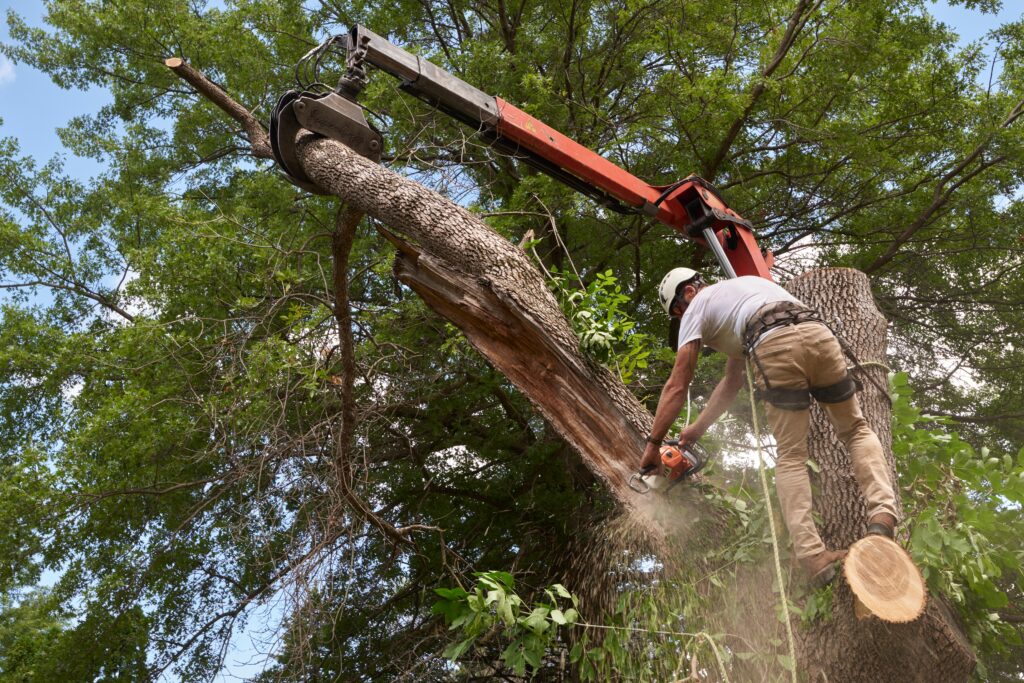Everything You Need to Know About Tree Removal

*Updated October 21st, 2025
Trees add beauty, shade, and even value to your property—but sometimes, they have to go. Whether it’s a dying tree, dangerously close to your house, or in the way of a renovation, tree removal is a reality many homeowners face.
But before you break out the chainsaw or call in the tree service pros, it’s important to understand the process, **removal cost/tree removal cost, and local regulations that might come into play.
In this guide to tree care decisions, we’ll cover everything you need to know about how to remove a tree, from spotting a problem to what happens after it’s gone—and how to hire the right **tree removal companies with great customer reviews.
Table of Contents
- Signs That a Tree Needs to Be Removed
- Tree Removal Process: What to Expect
- Cost of Tree Removal
- Tree Removal Permits and Legal Considerations
- What to Do After Tree Removal
- Hiring a Tree Removal Service
Signs That a Tree Needs to Be Removed
Not every tree in your yard is meant to last forever. Some trees become safety hazards, while others overgrow their space or fall victim to pest infestations or disease.
1. Dead or Dying Branches
Large sections of dead wood signal decline. Falling limbs increase potential damage risks—especially near your home, driveway, or sidewalk.
2. Leaning Trees and Structural Instability
A sudden tilt can indicate root failure or internal rot/internal decay. When a tree is close to structures or power lines, a removal specialist may recommend you remove your tree before storms make it hazardous.
3. Signs of Disease or Infestation
Mushrooms/fungi growing at the base of the tree, peeling bark, deep cracks in the trunk, or wilting leaves in season point to decline. Some invasive species—like tree of heaven or siberian elm—cause problems and often warrant professional tree removal.
4. Root Damage to Surfaces
Aggressive root systems can crack sidewalks and push up driveways or threaten foundations. Sometimes tree pruning helps; other times, you must remove a tree to prevent property damage.
5. Interference with Utilities or Structures
Branches near power lines or rubbing the roof may exceed what tree trimming can solve. If repeated trim cycles fail, tree removal becomes the safer long-term solution.
Tip: If unsure, consult an arborist/accredited tree care company for an on-site/onsite assessment.
Tree Removal Process: What to Expect
Tree removal isn’t just grabbing a saw—there’s planning, safety, and sometimes permits.
1. Assessment by a Professional
A professional tree pro (ideally an ISA-certified arborist) confirms whether prune or tree removal is appropriate, outlines the safest removal process, and identifies cost factors like the size of the tree and location of the tree.
2. Permits and Local Rules
Many cities require a permit—especially for larger trees or protected species. Your tree service company often handles paperwork for tree removal services near you.
3. Safe Work Steps
- Safety: Protects structures, fences, and landscaping.
- Proper equipment: Chainsaws, ropes, cranes, or bucket trucks for hard-to-reach or hard-to-reach area jobs.
- Sectioning: Crews remove limbs first, then lower the trunk in pieces to safely and efficiently remove the tree from your property.
- Cleanup: Most products and services include debris haul-off; you can request firewood or mulch left onsite.
4. Tree Stump Options
- Stump removal: Extracts stump and roots (best if replanting).
- Stump grinding: Fast, budget-friendly tree stump removal to below grade.
Cost of Tree Removal
Pricing varies by project. Here’s how tree costs typically break down and what you can expect to pay.
1. Key Cost Factors
- Size of the tree (smaller vs. larger trees with multiple stems)
- Location of the tree (open yard vs. close to your house/near your home/power lines)
- Site accessibility (fences, slopes, limited gate access)
- Tree condition (brittle wood, dead trees, emergency tree work after storms)
2. Typical Ranges (Ballpark)
- Smaller trees (under ~30′): lower overall cost
- Medium (30–60′): mid-range
- Tall/complex: highest professional costs (may require crane)
3. Add-Ons That Affect the Cost of Tree Removal
- Stump removal/stump grinding
- Log/brush haul-off
- Permit fees
- On-site chipper vs. haul-away
Note: Species can matter. Dense hardwoods (e.g., maple) or brittle crowns may change handling and price.
Tree Removal Permits and Legal Considerations
- Homeowner rules vary: some areas protect heritage trees or require mitigation plantings.
- HOAs may restrict removals or dictate replacements.
- Work near power lines usually requires utility coordination.
Check regulations first to avoid fines and delays.
What to Do After Tree Removal
1. Decide on Stump Treatment
Choose stump removal if you’ll replant or build; select grinding for fast lawn restoration.
2. Restore the Landscape
Reseed, add beds, or create a patio. If replanting, match mature size to space to prevent future conflicts.
3. Prevent Future Issues
Schedule tree care: routine tree trimming/prune with proper pruning helps avoid another costly removal project.
Hiring a Tree Removal Service
Choosing the right tree service protects your property and budget.
1. Questions to Ask
- Are you licensed, insured, and do you have an ISA arborist on staff?
- What’s included (stump, haul-off, permits)?
- How will you protect my property?
- Do you provide a written estimate and on-site/onsite evaluation?
2. Vet With Customer Reviews
Check Google/BBB, confirm accredited tree care company status, and compare multiple quotes from tree removal companies.
3. When to Hire a Professional
If a tree is close to structures, in a hard-to-reach area, or near utilities, hire a professional for professional tree removal to reduce risk.
Conclusion
Tree removal isn’t just cutting a tree—it’s ensuring it’s done safely, legally, and cost-effectively. Whether you’re dealing with an invasive tree of heaven, a nuisance species, or a hazardous specimen, the right tree service can manage permits, minimize potential damage, and deliver a clean result.
When in doubt, bring in a pro. A qualified team will assess risks, explain the cost of tree work, and complete the job to standard—so your yard (and wallet) are protected from start to finish.
Additional Home Improvement Resources

Anna has over six years of experience in the home services and journalism industries and serves as the Content Manager at MyHomePros.com, specializing in making complex home improvement topics like HVAC, roofing, and plumbing accessible to all. With a bachelor’s degree in journalism from Auburn University, she excels in crafting localized, comprehensive guides that cater to homeowners’ unique needs. Living on both coasts of the United States has equipped her with a distinctive perspective, fueling her passion for turning any house into a cherished home through informed, personalized decision-making.








